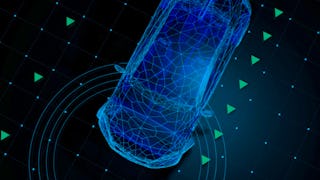This course will discuss different ways of formally modeling requirements of interest for autonomous systems. Examples of such requirements include stability, invariance, reachability, regular languages, omega-regular languages, and linear temporal logic properties. In addition, it will introduce non-deterministic finite and büchi automata for recognizing, respectively, regular languages and omega-regular languages.

Unlock access to 10,000+ courses with Coursera Plus. Start 7-Day free trial.

Requirement Specifications for Autonomous Systems
This course is part of Foundations of Autonomous Systems Specialization

Instructor: Majid Zamani
1,697 already enrolled
Included with
Recommended experience
What you'll learn
Utilize formal methods to specify and verify requirements for autonomous systems.
Model system behaviors and verify stability using various analytical methods.
Apply reachable set computation and robustness analysis in system design.
Skills you'll gain
Details to know

Add to your LinkedIn profile
7 assignments
See how employees at top companies are mastering in-demand skills

Build your subject-matter expertise
- Learn new concepts from industry experts
- Gain a foundational understanding of a subject or tool
- Develop job-relevant skills with hands-on projects
- Earn a shareable career certificate

There are 5 modules in this course
In this course, we delve into both low-level and high-level specifications, fundamental to the development of safe autonomous systems. This module is specifically designed to equip students with an in-depth understanding of expressing system behaviors through formal methods, including linear temporal logic and automata on both finite and infinite strings. Through a collection of detailed examples and practical applications, participants will acquire the skills needed to define and analyze key properties of autonomous systems, such as safety and reachability.
What's included
3 videos10 readings
This module offers a concise introduction to normed vector spaces and stability concepts in autonomous systems, encompassing both asymptotic stability and global asymptotic stability. It emphasizes the application of Lyapunov's Stability Theorem for the formal verification of these properties in complex systems, including its application to various simple systems, such as linear ones. Through illustrative examples, we will demonstrate the significance of these concepts in analyzing and ensuring the stability of systems.
What's included
14 videos1 reading2 assignments
Delve into the topic of reachable sets and uncover their critical role in guaranteeing system safety. This module introduces frameworks for exploring computational techniques to over-approximate reachable sets across diverse system classes. You will have the chance to apply your knowledge in real-world contexts, investigate the use of zonotopes, and recognize their beneficial properties in the computation of reachable sets. Moreover, we delve into fundamental concepts of formal languages, and regular and omega-regular expressions, offering succinct and formal methods to express regular and omega-regular languages, respectively.
What's included
7 videos1 reading1 assignment
This module immerses you in the essential principles of regular and ω-regular properties and how they are represented via non-deterministic finite automata (NFA) and Büchi automata (NBA), respectively. You will study the notation and architecture of NFAs and NBAs, master the construction of regular and ω-regular expressions, and grasp their correlation with these automata. The course will navigate you through the conversion of NFAs to regular expressions and NBAs to ω-regular expressions and the inverse, elucidating the significance of these concepts in the verification of finite and infinite behaviors of systems.
What's included
13 videos1 reading2 assignments
This module provides an in-depth exploration of Linear Temporal Logic (LTL) formulas, a mathematical formalism for describing languages containing infinite words. It presents a framework for articulating the temporal dimensions of system behaviors, offering a syntax that closely mirrors natural language. By melding propositional logic with temporal operators, LTL furnishes a powerful toolkit for specifying the rich behaviors of systems.
What's included
3 videos1 reading2 assignments
Earn a career certificate
Add this credential to your LinkedIn profile, resume, or CV. Share it on social media and in your performance review.
Build toward a degree
This course is part of the following degree program(s) offered by University of Colorado Boulder. If you are admitted and enroll, your completed coursework may count toward your degree learning and your progress can transfer with you.¹
Instructor

Offered by
Explore more from Design and Product
 Status: Free Trial
Status: Free TrialUniversity of Colorado Boulder
 Status: Free Trial
Status: Free TrialUniversity of Colorado Boulder
 Status: Free Trial
Status: Free TrialUniversity of Colorado Boulder
Why people choose Coursera for their career





Open new doors with Coursera Plus
Unlimited access to 10,000+ world-class courses, hands-on projects, and job-ready certificate programs - all included in your subscription
Advance your career with an online degree
Earn a degree from world-class universities - 100% online
Join over 3,400 global companies that choose Coursera for Business
Upskill your employees to excel in the digital economy
Frequently asked questions
To access the course materials, assignments and to earn a Certificate, you will need to purchase the Certificate experience when you enroll in a course. You can try a Free Trial instead, or apply for Financial Aid. The course may offer 'Full Course, No Certificate' instead. This option lets you see all course materials, submit required assessments, and get a final grade. This also means that you will not be able to purchase a Certificate experience.
When you enroll in the course, you get access to all of the courses in the Specialization, and you earn a certificate when you complete the work. Your electronic Certificate will be added to your Accomplishments page - from there, you can print your Certificate or add it to your LinkedIn profile.
Yes. In select learning programs, you can apply for financial aid or a scholarship if you can’t afford the enrollment fee. If fin aid or scholarship is available for your learning program selection, you’ll find a link to apply on the description page.
More questions
Financial aid available,


